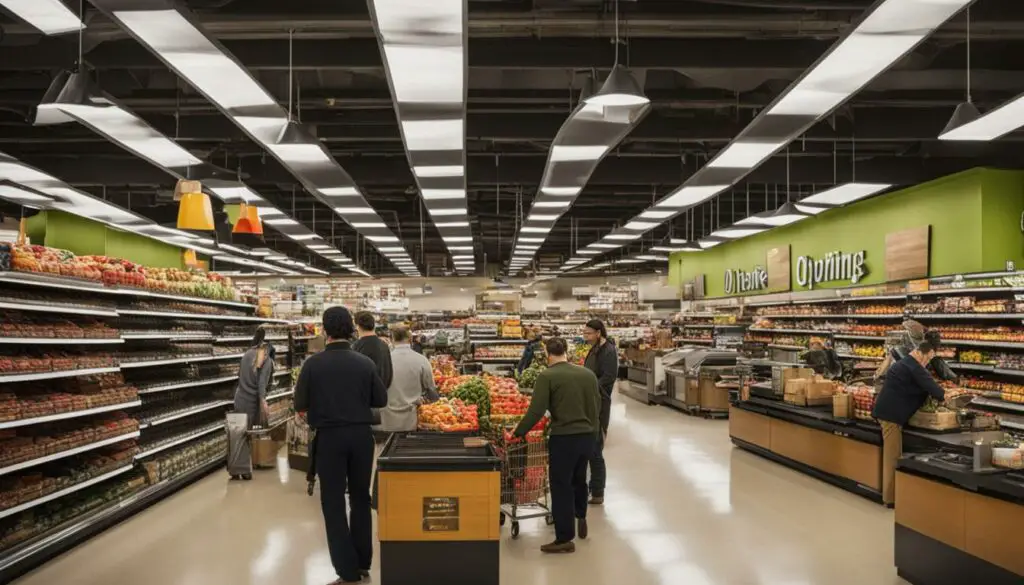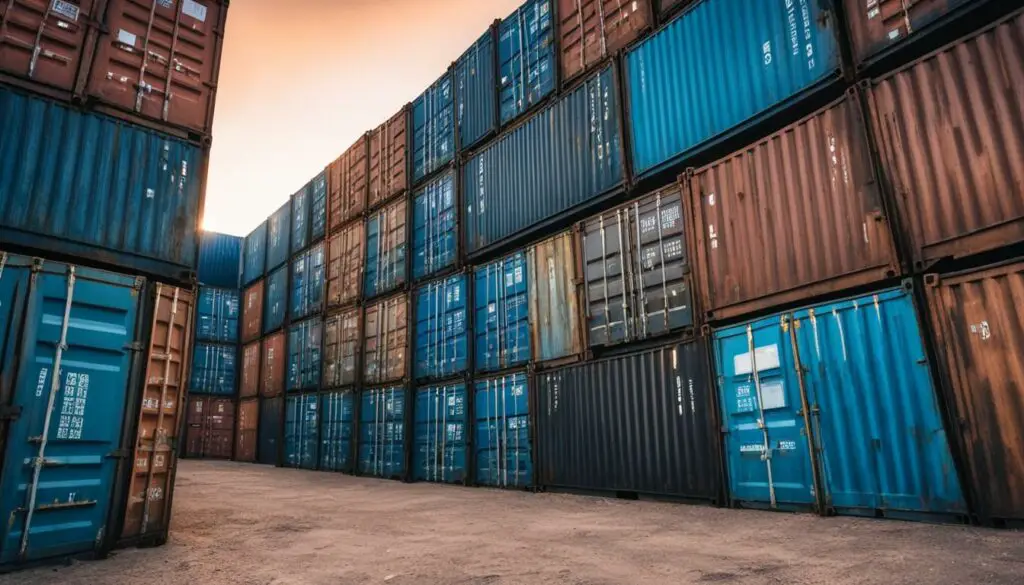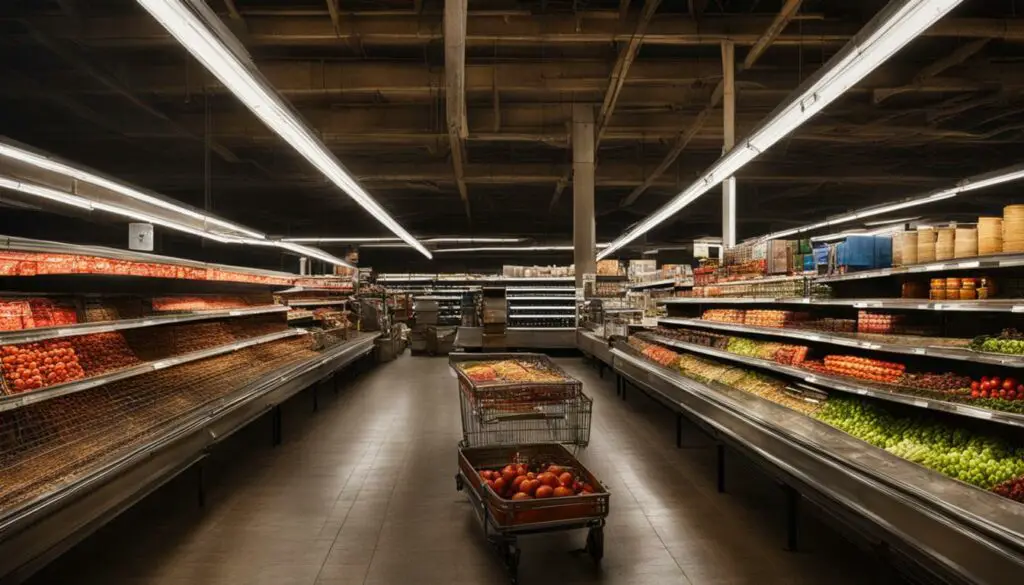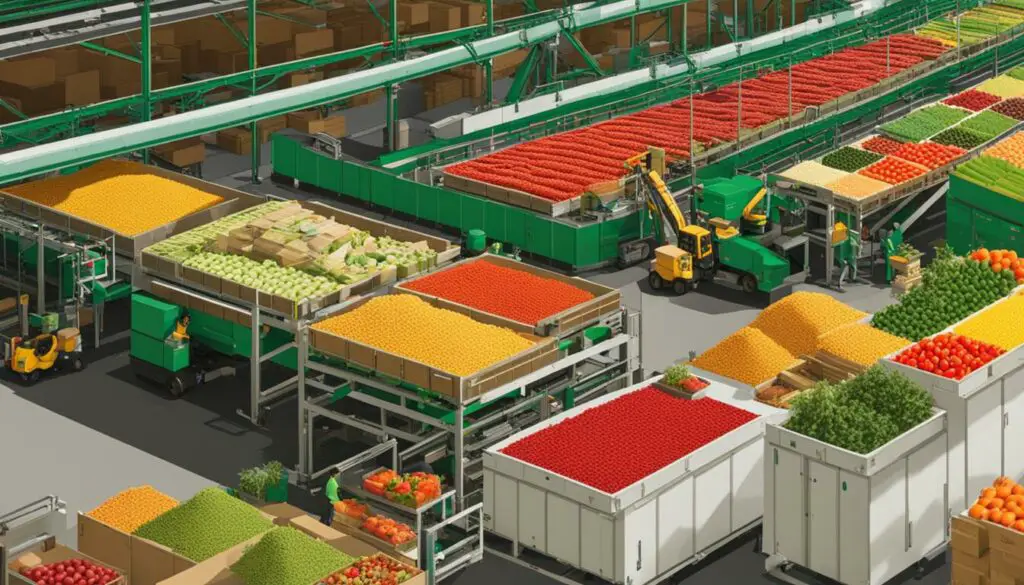Originally posted on December 24, 2023 @ 3:17 am
Grocery store shelves are empty once again, causing concerns and frustration among shoppers. The reasons for these shortages are multifaceted and include various factors impacting the food industry. Winter storms, labor shortages, the omicron variant, and supply chain disruptions are all contributing to the current state of empty grocery stores.
During these uncertain times, understanding the underlying reasons behind the empty shelves can help alleviate some of the frustrations and provide insight into the challenges faced by grocery stores and the broader supply chain.
Table of Contents
Key Takeaways:
- The empty shelves in grocery stores are due to various factors such as winter storms, labor shortages, the omicron variant, and supply chain disruptions.
- These shortages highlight the vulnerabilities in the grocery store supply chain and the challenges faced by the food industry.
- Understanding these factors can help consumers and retailers navigate these challenging times and adapt their strategies accordingly.
- The Biden administration has taken initiatives to address the supply chain crisis and strengthen food supply chains.
- Building resilient supply chains and ensuring reliable logistics systems can help mitigate future grocery store shortages.
The Impact of the Omicron Variant

The highly contagious omicron variant of COVID-19 is significantly affecting the food industry. Grocery store workers are contracting the virus at higher rates, leading to increased absences and making it harder for stores to keep their shelves stocked. The virus is also impacting the wider food industry supply chain, with workers throughout the production, manufacturing, shipping, and distribution process falling ill. This is causing supply challenges and further exacerbating the grocery store shortage situation.
| Impact of the Omicron Variant on the Food Industry | |
|---|---|
| Challenge | Effects |
| Grocery store worker infections | Increased absences, difficulty in restocking shelves |
| Food industry supply chain | Worker illnesses across production, manufacturing, shipping, and distribution processes leading to supply challenges |
As grocery store workers continue to contract COVID-19, their absence in the workplace hampers the ability to maintain inventory levels, resulting in empty shelves. The need for employees to quarantine or isolate further strains the supply chain, making it harder to meet the demands of consumers.
Additionally, COVID-19 infections among workers throughout the food industry supply chain pose even greater challenges. From the farms and production facilities to the transportation and delivery services, individuals falling ill disrupt the entire process of getting food from the source to the store. The lack of available workers, coupled with the surging demand for groceries, exacerbates the supply challenges and leaves grocery stores with depleted stock.
Labor Shortages in the Grocery Industry

The grocery industry is currently grappling with significant labor shortages, as many employees have chosen to leave their positions due to the challenging conditions brought on by the ongoing pandemic. Throughout the course of the pandemic, grocery store employees have been required to work in person, confront food shortages, and enforce public health measures, leading to exhaustion and increased resignations.
As a result, grocery stores are now operating with a lower workforce, which further exacerbates the already dire situation of empty shelves. To address this issue and attract new applicants, supermarkets are implementing various strategies. One such approach is offering higher pay to employees, recognizing their essential role during these trying times. By providing better benefits and increased security measures, supermarkets aim to entice individuals to join the workforce and contribute to restocking store shelves.
The labor shortages in the grocery industry highlight the need for long-term solutions to address the challenges faced by employees. Strategies focusing on higher pay and improved working conditions have the potential to not only attract new talent but also retain existing employees. By investing in their workforce and ensuring employee satisfaction, grocery stores can mitigate the impact of labor shortages and contribute to the overall stability of the food supply chain.
“The current labor shortages in the grocery industry are a direct result of the demanding conditions experienced during the pandemic and the subsequent burnout and resignations of employees. It is crucial for supermarkets to offer higher pay, better benefits, and increased security measures to attract new workers and maintain a stable and efficient workforce.”
Trucking and Shipping Challenges
Trucking shortages and shipping delays are adding to the hardships faced by grocery stores in maintaining their supply chains. The trucking industry is struggling to find enough drivers to meet the increasing demand for ground transportation. This shortage of drivers has resulted in delays in transporting goods from warehouses to stores, further exacerbating the empty shelves.
Moreover, severe weather events and the effects of climate change have had a significant impact on transportation routes. Harsh weather conditions, such as storms and heavy snowfall, make it even more challenging to move food and essential items efficiently. These transportation disruptions have contributed to shipping delays and increased the costs associated with transporting goods, adding pressure to an already strained grocery supply chain.
To illustrate the severity of the situation, here is a table showcasing the impact of trucking shortages, shipping delays, and transportation disruptions on grocery stores:
| Challenges | Effects |
|---|---|
| Trucking shortages | Delays in transporting goods, difficulty in meeting demand |
| Shipping delays | Delayed arrival of inventory, reduced stock availability |
| Transportation disruptions | Difficulty in moving goods due to severe weather and climate change impacts |
| Increased shipping costs | Higher expenses for transportation, putting strain on supply chains |
As a result of these challenges, grocery stores are struggling to restock their shelves in a timely manner, leading to ongoing shortages and customer frustration. The impacts of trucking shortages, shipping delays, transportation disruptions, severe weather events, and increased shipping costs highlight the urgent need for solutions to address these issues and ensure a more reliable and efficient supply chain for essential goods.
“The ongoing trucking and shipping challenges have further strained the already stressed grocery supply chain, making it difficult for stores to keep their shelves stocked with essential items.”
Climate Change and Severe Weather Impacts

Climate change is having a profound impact on food production and availability, leading to shortages in grocery stores. The increasing frequency and intensity of severe weather events, such as heavy rains and storms, are disrupting crop yields and limiting the production of essential food items.
These extreme weather conditions pose significant challenges to farmers, affecting the cultivation of crops that contribute to the availability of meat, eggs, and dairy products. For instance, reduced yields of corn and soybeans, which are vital feed ingredients for livestock, directly impact the production and price of meat, eggs, and dairy.
Severe weather events not only hinder crop growth but also cause transportation disruptions that further compound the challenges faced by the food industry. Limited accessibility and damaged infrastructure make it harder to move food from farms to grocery stores, exacerbating the already constrained supply chain.
It is crucial to address the impact of climate change on food production to ensure a stable and sustainable food supply. Efforts should be made to adapt agricultural practices and invest in climate-resilient strategies that mitigate the effects of severe weather events.
Here is a table showcasing how climate change affects the availability of meat, eggs, and dairy:
| Effect of Climate Change | Consequences |
|---|---|
| Reduced crop yields | Decreased feed availability for livestock, resulting in lower meat, eggs, and dairy production. |
| Extreme weather events | Disrupted transportation and damaged infrastructure, leading to delays in delivering meat, eggs, and dairy products to grocery stores. |
| Higher production costs | Investments in climate-adaptive measures drive up the cost of raising livestock and producing meat, eggs, and dairy. |
| Food price inflation | Limited supply and increased costs result in higher prices for meat, eggs, and dairy products, impacting consumers’ affordability. |
Climate change is a pressing issue that requires proactive action from individuals, communities, and policymakers. By addressing the underlying causes and implementing sustainable solutions, we can build a more resilient food system that can withstand the challenges posed by climate change and ensure the availability of essential food items.
Container Shortages and Supply Chain Challenges

The global container shortage is causing major disruptions in supply chains, leading to increased shipping costs, production delays, and significant impacts on various industries, including the electronics sector. The shortage of shipping containers has created a domino effect, straining the already stressed supply chain and contributing to the empty shelves in grocery stores.
The demand for shipping containers has far exceeded the available supply, resulting in a scarcity that has driven up shipping costs. As a result, companies across different sectors, including electronics giants like Sony, Apple, and Microsoft, are experiencing difficulties reliably shipping their products. The lack of reliable containers has caused logistical challenges, delays, and increased expenses for these companies.
| Impacts of Container Shortages | Key Challenges and Consequences |
|---|---|
| Increased shipping costs | Higher expenses for companies, which may ultimately be passed on to consumers. |
| Production delays | Delayed shipments and reduced productivity for businesses. |
| Shift to ocean freight | The container shortage has led to a shift in transportation modes, causing congestion in sea routes. |
| Impact on the electronics industry | Companies in the electronics sector are struggling to reliably ship their products, affecting availability and supply chain stability. |
The shift to ocean freight as a result of the container shortage has congested sea routes, further exacerbating the problem. This congestion increases the delivery time for goods, which can lead to stockouts and delays in replenishing inventory for various industries, including the electronics industry.
The impact of container shortages and supply chain challenges goes beyond a single industry. The strain on the supply chain affects the availability and affordability of goods, including essential products found in grocery stores. As the electronics industry struggles to navigate the container shortage, it adds to the overall stress on the supply chain, contributing to the empty shelves in grocery stores that consumers are experiencing.
Container shortages have significant implications for global supply chains, leading to increased shipping costs, production delays, a shift to ocean freight, and impacting various industries, including the electronics sector.
Impact on Industries and Products

The ongoing shipping crisis and supply chain disruptions have had a significant impact on various industries and products, causing shortages and price increases. Let’s take a closer look at some of the sectors facing challenges.
Automotive Industry:
The automotive industry is grappling with a microchip shortage, which has resulted in limited inventory and higher prices for cars. The scarcity of microchips, essential components in modern vehicles, has disrupted the production and distribution processes, leading to delays and increased costs for consumers.
Electronics Industry:
The microchip shortage has also affected the electronics industry, resulting in reduced availability and higher prices for electronic devices such as smartphones, laptops, and gaming consoles. Manufacturers and retailers are struggling to meet the demand due to the limited supply of microchips.
Shoe Industry:
The shipping crisis has caused delays and increased costs in the shoe industry. Manufacturers and retailers are facing challenges in sourcing raw materials, transporting finished products, and managing inventory. This has led to shortages of popular shoe brands and higher prices for consumers.
Canned Foods and Beverages:
The disruptions in the supply chain have impacted the availability of canned foods and beverages. Delays in transportation and production have resulted in shortages of canned goods and popular beverages in grocery stores. As a result, consumers may find it more difficult to find their preferred canned food items.
Cleaning Supplies:
The increased demand for cleaning supplies during the pandemic, combined with supply chain challenges, has led to shortages and price increases. Consumers may experience difficulty finding essential cleaning products like disinfectants, wipes, and sanitizers.
To illustrate the impact visually, let’s take a look at some data:
| Industry/Product | Impact |
|---|---|
| Automotive Industry | Microchip shortage causing limited inventory and increased prices. |
| Electronics Industry | Reduced availability and higher prices for electronic devices. |
| Shoe Industry | Shortages of popular shoe brands and higher prices. |
| Canned Foods and Beverages | Delays and shortages in canned goods and popular beverages. |
| Cleaning Supplies | Shortages and price increases for essential cleaning products. |
The Global Empty Shelf Crisis

Empty shelves in grocery stores are not unique to the United States. The global food supply chain is facing significant challenges due to the COVID-19 pandemic. Labor shortages, shipping delays, and supply chain disruptions are impacting grocery stores and causing shortages worldwide. Countries like Australia are also experiencing severe shortages, with large percentages of grocery store workers testing positive for COVID-19.
The global empty shelf crisis has been exacerbated by various factors, including the ongoing labor shortages in the food industry. With grocery store workers falling ill or having to isolate due to COVID-19, there is a reduced workforce available to stock the shelves and meet consumer demand.
Shipping delays have also played a significant role in the empty shelves phenomenon. Restrictions on travel and increased demand for online shopping have put immense pressure on shipping companies, leading to longer delivery times and disrupted supply chains. As a result, grocery stores are struggling to receive the necessary stock on time, resulting in empty shelves and frustrated customers.
The impact of COVID-19 on supply chains cannot be underestimated. Not only has there been a disruption in the flow of goods, but there have also been restrictions on manufacturing and production. Many factories and processing plants have had to close temporarily, further limiting the availability of essential products on grocery store shelves.
The global empty shelf crisis requires collaborative efforts from all stakeholders involved in the food supply chain. Governments, businesses, and consumers must work together to address the challenges and find innovative solutions. This crisis has highlighted the importance of building resilient and adaptable supply chains that can withstand unforeseen events.
Quotes:
“The global empty shelf crisis is a clear indication of the vulnerability of our current supply chains. As we navigate the challenges posed by the COVID-19 pandemic, it is crucial to prioritize the strengthening of our food supply chains to ensure the consistent availability of essential products.” – Food Industry Expert
Impact of the Global Empty Shelf Crisis
| Impacted Areas | Key Challenges |
|---|---|
| Grocery Stores | Labour shortages, shipping delays, disrupted supply chains |
| Manufacturing and Production | Factory closures, restricted operations, reduced output |
| Shipping and Logistics | Increased demand, supply chain congestion, longer delivery times |
| Consumer Demand | Frustrated customers, limited product availability, higher prices |
Efforts to Address the Crisis

The Biden administration is actively tackling the supply chain crisis and implementing initiatives to strengthen food supply chains, improve logistics, and address labor shortages. These efforts aim to alleviate the challenges faced by the grocery industry and reduce the occurrence of empty shelves in stores.
One of the key initiatives the Biden administration has taken is dedicating funds to expand and diversify meat processing capabilities. This investment will help increase the capacity of meat processing facilities, ensuring a steady supply of meat products to grocery stores.
In addition, the administration is focused on improving logistics and transportation infrastructure. By investing in transportation systems, such as roads, railways, and ports, the administration aims to enhance the efficiency of the supply chain, expedite the movement of goods, and reduce transportation-related bottlenecks.
Addressing the labor shortages in the grocery industry is another priority for the Biden administration. Recognizing the importance of essential workers, the administration is working towards creating initiatives that attract and retain talent in the sector. This includes offering competitive wages, better benefits, and improved working conditions to ensure a robust workforce.
By taking these measures, the Biden administration aims to make the food supply chain more resilient, ensuring a steady flow of essential goods to grocery stores. These efforts will not only address the immediate crisis but also lay the foundation for a more efficient and reliable supply chain in the future.
| Initiative | Description |
|---|---|
| Expansion of Meat Processing Capabilities | Dedicating funds to increase the capacity of meat processing facilities, ensuring a steady supply of meat products to grocery stores. |
| Improving Logistics and Transportation Infrastructure | Investing in transportation systems, such as roads, railways, and ports, to enhance the efficiency of the supply chain and reduce transportation-related bottlenecks. |
| Addressing Labor Shortages | Creating initiatives to attract and retain talent in the grocery industry by offering competitive wages, better benefits, and improved working conditions. |
Uncertain Future and Higher Prices
The future of grocery store shortages remains uncertain, with challenges still persisting in the supply chain. The impact of labor shortages, transportation disruptions, and other factors continue to affect the availability of products on store shelves. As a result, consumers can expect higher prices for groceries as retailers grapple with increased costs.
This uncertain future has a direct impact on consumers, who are likely to experience the pinch of rising prices in their wallets. The scarcity of certain goods, combined with the elevated costs of transportation and logistics, means that retailers may pass on these expenses to consumers in the form of higher prices.
To navigate these uncertain times, retailers need to prioritize building resilient supply chains. This means establishing robust relationships with suppliers, investing in technological advancements, and implementing effective inventory management systems. Resilient supply chains can help mitigate the impact of future disruptions and ensure a steady flow of goods to meet consumer demands.
“The uncertain future of grocery store shortages and higher prices highlights the need for retailers to invest in resilient supply chains.” – Retail industry expert
Additionally, retailers should also explore alternative sourcing options and consider diversifying their supplier base to reduce dependence on a single source. By diversifying, they can mitigate the risk of supply chain disruptions and ensure a more stable inventory of goods.
Benefits of Resilient Supply Chains
Building resilient supply chains offers several benefits for retailers amidst an uncertain future:
- Increased agility: Resilient supply chains enable retailers to quickly respond to unexpected disruptions and adjust their strategies accordingly.
- Enhanced customer satisfaction: Reliable supply chains ensure that retailers can meet customer demands, reducing the frustration of empty shelves and product unavailability.
- Improved cost management: By optimizing their supply chains, retailers can minimize costs and pass on the savings to consumers.
- Supply chain transparency: Resilient supply chains facilitate greater transparency, allowing retailers and consumers to have a clearer view of the product journey and its impact on pricing.
Investing in resilient supply chains is crucial not only for the short-term mitigation of grocery store shortages but also for the long-term sustainability of the industry. With an uncertain future ahead, retailers must proactively adapt and build robust systems to ensure a reliable and affordable supply of groceries for consumers.
| Impact | Consumer | Retailers |
|---|---|---|
| Higher prices | Consumers experience the pinch of rising prices | Retailers face increased costs and pricing challenges |
| Shortages | Consumers face empty shelves and limited product availability | Retailers struggle to maintain sufficient inventory and meet consumer demands |
| Supply chain disruptions | Consumers may experience delays in product restocking and delivery | Retailers grapple with logistics challenges and operational inefficiencies |
Conclusion
The widespread shortage of products in grocery stores can be attributed to a combination of factors, including the impact of the omicron variant and disruptions in the supply chain. Labor shortages, transportation challenges, and climate change are also contributing to the empty shelves that consumers are encountering.
The omicron variant has had a significant impact on the grocery industry, with workers contracting the virus at higher rates. This has led to increased absences and difficulty in keeping store shelves adequately stocked. Additionally, supply chain disruptions caused by the pandemic have further strained the availability of essential goods.
The Biden administration has taken steps to address the crisis, including initiatives aimed at strengthening food supply chains and improving logistics. However, the future remains uncertain, and retailers need to prioritize resilience and adaptability in their supply chains to meet consumer demands during these challenging times.
In summary, grocery store shortages are the result of a complex interplay between factors such as the omicron variant, supply chain disruptions, labor shortages, and the impact of climate change. By implementing measures to enhance supply chain resilience and adapt to changing circumstances, retailers can better navigate the uncertain future and ensure that consumers have access to the products they need.
FAQ
Why are grocery stores empty?
Grocery stores are experiencing shortages due to various factors, including the impact of the omicron variant, labor shortages, transportation challenges, supply chain disruptions, climate change, and container shortages.
How is the omicron variant affecting grocery stores?
The omicron variant is significantly affecting grocery stores by causing COVID-19 infections among workers, leading to increased absences and making it harder for stores to keep their shelves stocked. It is also impacting the wider food industry supply chain, with workers throughout the production, manufacturing, shipping, and distribution process falling ill.
Why are there labor shortages in the grocery industry?
Labor shortages in the grocery industry are a result of challenging conditions brought on by the pandemic. Grocery store workers have been required to work in person throughout the pandemic, deal with food shortages, and enforce public health measures, leading to burnout and resignations. Many stores are operating with a reduced workforce, and to attract new applicants, supermarkets are offering higher pay, better benefits, and increased security measures.
How are trucking and shipping challenges impacting grocery stores?
Trucking shortages and shipping challenges are contributing to the difficulties faced by grocery stores. The trucking industry is struggling to find enough drivers to meet the demand for ground transport. Additionally, severe weather events and climate change are impacting transportation routes and making it harder to move food and goods, leading to shipping delays and increased shipping costs.
How is climate change impacting grocery store shortages?
Climate change is affecting food production and availability, leading to shortages in grocery stores. Severe weather events, such as heavy rains and storms, are impacting crop yields and limiting the production of essential food items. This, in turn, affects the availability and price of meat, eggs, and dairy products. Severe weather also causes transportation disruptions, making it harder to move food around.
What is the impact of container shortages on grocery stores?
Container shortages have resulted in increased shipping costs and production delays for various goods. The shift to ocean freight, caused by the container shortage, has congested sea routes and impacted the electronics industry. Electronic companies are struggling to reliably ship products, which further strains the supply chain and contributes to the empty shelves in grocery stores.
Which industries and products are impacted by the empty shelf crisis?
Various industries and products are affected by the shipping crisis and supply chain disruptions. The automotive industry is experiencing a shortage due to the lack of microchips, leading to limited inventory and increased prices for cars. The electronics industry is also affected by the microchip shortage, resulting in reduced availability and higher prices for electronic devices. The shoe industry, canned foods and beverages, and cleaning supplies sectors are also experiencing shortages and price increases.
Are grocery store shortages a global issue?
Yes, empty shelves in grocery stores are not unique to the United States. The global food supply chain is facing significant challenges due to the COVID-19 pandemic. Labor shortages, shipping delays, and supply chain disruptions are impacting grocery stores and causing shortages worldwide.
What efforts are being made to address the grocery store shortage crisis?
The Biden administration has taken measures to address the supply chain crisis and strengthen food supply chains. These initiatives include dedicating funds to expand and diversify meat processing capabilities, improving logistics and transportation infrastructure, and addressing labor shortages.
What does the future hold for grocery store shortages?
The future of grocery store shortages remains uncertain, with challenges still persisting in the supply chain. Consumers can expect higher prices for products due to scarcity and increased transportation costs. Retailers need to focus on building resilient supply chains and ensuring they have reliable logistics systems in place to meet consumer demands during these challenging times.
Source Links
- https://www.npr.org/2022/01/12/1072462477/grocery-shortage-shelves-reasons
- https://slate.com/business/2022/01/grocery-store-shortage-empty-shelves-explained.html
- https://shiphero.com/blog/the-empty-shelf-crisis-of-2022/
See also:
Leave a Reply